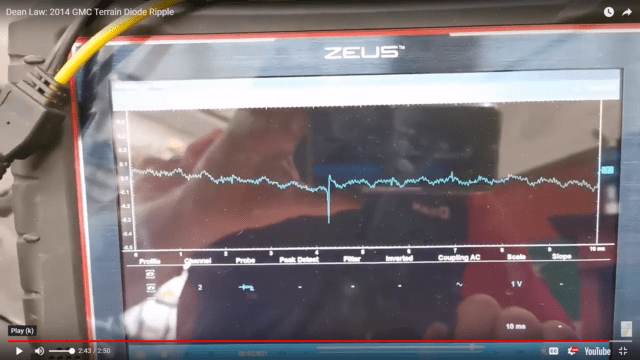We welcome our newest Indie Garage contributor Dean Law of Law’s Automotive in Portage la Prairie, MB with this look at diode ripple.
Dean has been creating his own videos and we liked his down to earth, real world approach. So we are very pleased to add his authentic shop owner voice to our regular contributions online and in print. Welcome aboard Dean!
___________
Hey: 2014 GMC Terrain. We have already done a state of charge on the battery so I’m not going go over that. My videos have already gone over the information and description of what that is, what a state of charge is. So what we’re gonna be doing today is we’re going to be doing a diode ripple (test).
Since the battery has been weakened but we don’t know how long it’s been weak for. The customer has been noticing that it was getting slower to start so we know the battery is actually getting weak.
The other thing that you need to know about that is it’s computer-controlled. If everybody’s been following what I’ve been talking about there is a clamp right down there can you see that.
That clamp allows the computer up top here to know how much load is on the circuit. And since it’s pulse-width, the alternator is pulse-width duty cycle nowadays right there. So that is quite a drain on the battery–on the alternator sorry–so what do we now do is we test that.
Well, we can get a special machine or we can actually go through here okay.
Let’s change that from 20 volts because we’ve been checking the state of charge. Let’s go up to 1 volt.
Let;s change the time. Usually roughly 20 milliseconds is a good time to start with. And the other thing we need to do: Why can’t we see anything?
Where is it? Well as we notice on the live information, it’s way off the chart. So what do we need to do? Now let’s think about this. We are checking alternating current, diode ripple. What’s the alternator doing? It’s taking alternating current and changing it to direct current through a rectifier.

The rectifiers are made out of diodes. If the diodes are starting the short, you see dropouts, How do we get to see this ? Well AC coupling. That’s what that one’s for.
Oh there it is! Alright see all those little spikes that are coming up? Those spikes shouldn’t be there. So let’s put a hypothetical load on the circuit. You can hear the alternator starting to kick in.
You see those drop outs?
That’s the alternator. That’s the ripple that we’re not wanting to see. But even on here you can see those spikes. We don’t want to see those spikes on there, We want to be seeing a nice uniform waveform. Really to be honest.
So just for a little bit of information today. See those spikes up here?
They shouldn’t be there. So just a little bit of information on diode ripple what does it mean what does it look like.


COOOOOOOOOOOOOOOLIDGE!! 🙂